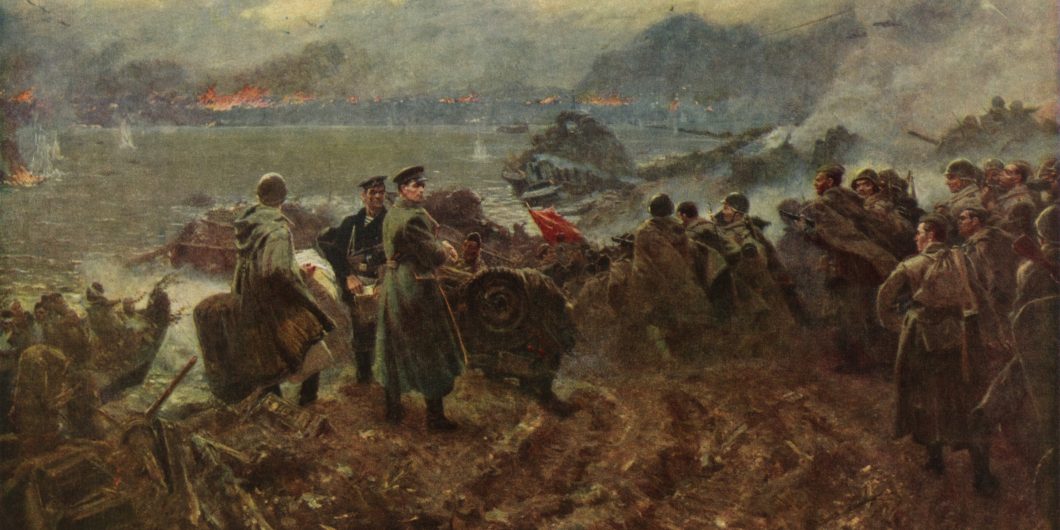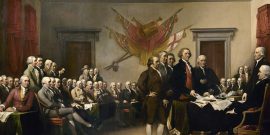Not so long ago, statesmen delivered speeches to reforge a sense of national identity by invoking the principles of the Declaration of Independence.
A Hollow Victory in the “Good War”
The goals of the Western Allies in World War II were to defeat Hitler and prevent a hostile power from entrenching itself in Europe and Asia, threatening the freedom and survival of the West. From a narrow perspective, the unconditional surrender of Germany and Japan in 1945 fulfilled this objective: it was a victory for the United States, the United Kingdom, and their allies, and we celebrate V-E Day every May 8 and V-J Day on September 2. But for a large number of nations that fought against Berlin and Tokyo, at enormous sacrifice, 1945 is a dark year that ended one tyranny only to be replaced by another one, the Communist one, which was (and continues to be) no less vicious and in fact was much more lasting and pervasive. Stalin replaced Hitler. Or, to put it in the context of World War II, Stalin was the clear winner of that conflict. It was his war, and he got the most out of it.
This is the argument of a new book, Stalin’s War, by a prolific and excellent historian, Sean McMeekin of Bard College. The author is already well known, having written highly readable and incisive books exploring the role of Russia, the Ottoman Empire, and Germany in the origins of World War I. In his new work, he focuses on Stalin, his objectives, his tactics, his actions, and, above all, his ability to obtain from his Western counterparts everything (and more!) that he wanted. The book presents the story of Stalin’s success that brought an enormous human cost to his own people and to those who came under Communist domination, as well as an enduring geopolitical cost. Through this war, Stalin succeeded in anchoring Soviet power and influence over Eurasia, benefiting from the frailty of European powers. Germany was obviously reduced to rubble by 1945, but even the victorious powers, from France and the UK to the other smaller states across the continent, were mere shadows of their former selves. Stalin gained strategic real estate and the tools, looted from Europe or given to him by the United States, to turn Russia into an industrial superpower. The conditions for the Cold War were in place, and in the immediate aftermath of the war, the possibility that Stalin could become the master of Eurasia was not out of the question. And, for the U.S., victory in 1945 meant not a satisfying and prolonged age of peace, but the beginning of a new and massive investment in preserving its security and the stability threatened by the Soviet Union.
The story presented in such a way is not new, and its broad contours are accepted by most, except those who still see Communist ideology and the USSR as a benign progressive force or those who blame American post-war support of Western Europe for the Cold War. But McMeekin digs deeper and his goal is to change two pervasive myths. One presents Stalin as a paranoid dictator bumbling across the European chessboard, getting caught unprepared for Hitler’s aggressive intents, and then rising to the historic occasion and motivating his people to fight the “Great Patriotic War” to liberate Russia and the adjoining lands from the Nazis. In brief, a dictator to be sure, but a naive one with a great patriotic heart backed by a Russian nation willing to accept great sacrifices.
The other myth is of a strategically wise leadership of Franklin D. Roosevelt and Winston Churchill, skillfully making their moves across the world’s map, negotiating with a vast array of strategic partners (including Stalin) and organizing bold military actions that ultimately lead to the 1945 triumph. Neither myth, however, is entirely correct, as McMeekin brilliantly argues backed by abundant facts supplied through impeccable research.
Planned Conquest
Stalin was always interested in a war, especially one that would pit the other powers against each other. The expansion of Soviet influence and control required the weakening of the other powers, in particular the Western ones that were opposed to the Communist virus. For Stalin, therefore, the growth of Nazi Germany was a great opportunity: a violent and expansionistic power in the middle of Europe that could take the first swing against the polities standing on his path. Unsurprisingly, the Soviet tyrant was deeply disappointed when France and Britain signed the Munich Agreement with Nazi Germany in 1938 postponing the great European war that he desired. The 1939 Ribbentrop-Molotov Pact coordinated the efforts of Hitler and Stalin, but it benefited the latter more, allowing him to conquer a large swath of Polish territory with minimal effort, eliminating one of the staunchest opponents to Russian westward expansion. A year later, by murdering almost 22,000 Polish officers in Soviet captivity, Stalin further weakened the Polish obstacle to his expansion. “Nations which had been ruled by powerful aristocracies,” Stalin told once to the Yugoslav Milovan Djilas, “like the Hungarians and the Poles, were strong nations”—and, fearing them, he sought to eliminate them. Then, while Germany invaded France, Stalin took over the three Baltic states in a further step westward.
Hitler’s decision to invade Russia in mid-1941 was a surprise to Stalin, but not because he was expecting a lasting peace on his western frontier. Rather, as McMeekin documents, Stalin had ordered very rapid and large military preparations, building airbases and placing forces near the border with the Third Reich in the first half of 1941. None of them were in a defensive posture, and presented a vulnerable high value target to Nazi attacks. When Hitler decided to attack the USSR in June 1941, these Soviet forces were easy pickings for the well-organized, trained, and war tested German army. McMeekin here expands and amends a bold thesis offered in 1990 by Viktor Suvorov, a pseudonym for a GRU agent who defected to the West in the late ‘70s and became a historian, that argued that Stalin was actively planning an attack on Germany but was preempted by Hitler. While Suvorov was excessive in his claim that the Red Army was ready for an offensive campaign in 1941 (because, among other reasons, the officer corps was still in shambles after Stalin’s purges) and that Stalin had plans to conquer Europe, he argued that the USSR was never a status quo power satisfied in its borders. After all Soviet Russia had already attempted to march westward in 1920 and was stopped only by the Poles in a desperate battle near Warsaw (the “Miracle on the Vistula”). This westward vector and ambition of Moscow did not abate, and had to pause because of Hitler’s rise and the might of Nazi Germany. As McMeekin points out, the Soviet military posture in 1941 makes no sense if the goal was to defend Soviet-held lands, suggesting that Stalin was thinking of pouncing on Berlin, now the last remaining continental power in Europe. As the Soviet tyrant himself put it, the USSR no longer needed to be locked in a defensive posture, and was “a rapacious predator, coiled in tense anticipation, waiting for the chance to ambush its prey.”
Stalin, that is, was not an innocent victim of Hitler. Not only he was an active partner from 1938 until 1941, but also he had geopolitical aspirations that were more ambitious than those held by Hitler. And he pursued them methodically and ruthlessly, leaving a trail of death that dwarfed the one produced by the Nazis.
McMeekin then focuses on how the Western allies, Churchill but especially FDR, abetted Stalin’s ambitions. This part of the book is fascinating and depressing at the same time. In a nutshell, Stalin obtained from FDR more than he expected: territory, influence, and materiel. And he did not give anything in exchange for it because FDR and his advisors never asked him for it. For instance, FDR supported the Lend-Lease program, putting his friend Harry Hopkins in charge. Under this program of military aid, the United States supplied a massive amount of weapons, trucks, airplanes, tanks, foodstuff to the Soviet Union in the months of its greatest need, as German troops were driving deep into Russia while the vaunted Soviet armies were melting away. Without such aid, the USSR would have likely been unable to stop the German onslaught and certainly would have been incapable of mustering the resources necessary to push westward. Hence, in this moment there was a good strategic rationale for the American support of Stalin’s defensive efforts against Nazi Germany.
Kindness Unrewarded
But the problem was that FDR—and Hopkins—went much further than simply buttressing a collapsing Soviet power. The most stunning mistake—a policy willfully pursued by FDR—was that Stalin was never asked for anything in exchange for this material aid. The United States had the upper hand because the Soviets were desperate for any help and would have paid a price for these goods. As McMeekin comments, FDR “could have asked any price: payment in cash, by loan, or in kind; political concessions inside Russia; or promises from Stalin of better behavior abroad, such as abandoning his spying operations in Washington or offering token support for the US-British war against Japan. Instead, the Americans simply gave and demanded nothing in return aside from a vague, nonbinding promise of loan repayment beginning five years after the war was over, at no interest.”
Such a naivete could have been the result of FDR’s belief in his personal capacity to persuade people. But, at best, FDR profoundly misunderstood Stalin, despite the evidence of Soviet actions and even of Stalin’s own words and behavior toward the US President. FDR thought that he could build goodwill with Stalin. As he put it, “I think that if I give him everything I can and ask for nothing in return, noblesse oblige, he won’t try to annex anything and will work with me for a world of democracy and peace.” This is the point where naivete became stupidity. FDR at this point in time had plenty of evidence of Stalin’s ruthlessness and imperial ambitions: from the 1930s purges to the Holodomor in Ukraine, from the Ribentropp-Molotov pact to the Katyń massacre, the list was long and for everyone to see. But FDR continued to hope against hope that his own skills could soften Stalin’s behavior and that an international institutional scheme of cooperation (that turned into the United Nations) could turn the Soviet Union into a power in harmony with the rest of the world.
Stalin knew that he was getting a good deal. And he relished humiliating the Western leaders, including FDR, who had to fly to Yalta for his last summit, despite his physical frailty and his repeated pleading with Stalin to meet in a more accessible location.
FDR was also not well served by his closest advisors. The individual who comes out in the worst light in McMeekin’s book is FDR’s friend and advisor, Harry Hopkins. While managing the Lend-Lease program, he favored his Soviet consumers above the US Army and the American citizen. As he himself put it, “We are determined that nothing shall stop us from sharing with [Soviet Russia] everything we have.” Hence, the United States had a butter shortage because Hopkins sent it to the USSR (the Soviets rejected oleomargarine as a substitute). American airplanes were delivered to Stalin, despite the urgent needs of the US military. A lot of technology was also transferred, some in the open, some stolen by Soviet officials who were allowed to visit anywhere in the U.S. (while American observers were not permitted to do the same in the USSR). For example, Soviet visitors managed to obtain intelligence on the US Norden bombsight targeting systems, one of the technological marvels that gave an edge to US forces. But the list of the technologies given to the USSR is long: steam turbine power plants, steel-rolling mill, plans for an oil refinery, and even a vitamin factor. The Soviets wanted technological know-how, and not just products, in a clear effort to improve their capabilities for the future rather than simply providing for the immediate needs of the Red Army at war. And while they kept demanding more and more, including silver braid for the new uniforms of their officers, Hopkins supplied it all.
Even more, Hopkins promised Stalin to keep “anti-Soviet types” away from FDR, and kept true to that promise by purging the US Department of State of its greatest Soviet experts who had a more clear-eyed view of this totalitarian dictatorship. Hopkins was both ideologically pro-Soviet and vindictive (as well as close to FDR)—a mix that silenced most individuals in the US government who knew the not-so-hidden nature of the Soviet regime and of its leader and thus were skeptical of such unconditional support for Stalin.
Tragic Betrayals
Stalin knew that he was getting a good deal. And he relished humiliating the Western leaders, including FDR, who had to fly to Yalta for his last summit, despite his physical frailty and his repeated pleading with Stalin to meet in a more accessible location. This personal humiliation went hand in hand with the geopolitical one: Stalin asked and received control and influence over the territories of nations, from Poland and Yugoslavia to China, that were fighting alongside the Allies. The brilliance of Stalin—and of his supporters and abettors in the West—was to deprive the United States and Great Britain of local allies in various regions, from the Polish government in exile to Mihailović in Yugoslavia and Chiang Kai-shek in China, that allowed them to have a foothold in the local political and military dynamics. Stalin had his own local marionettes, created ex nihilo (e.g., the Polish Communist government in Lublin) or boosted by his support (e.g., Tito in Yugoslavia). The mistake of the Western allies was to accept these Soviet puppets as the main legitimate representatives of these nations. As Hopkins said during the Yalta conference, “the United States would desire a Poland friendly to the Soviet Union” The result was foreseeable: Stalin had control. And bequeathing these nations to Stalin and Communist dictators was a betrayal of tragic proportions.
McMeekin’s book is, on top of making for great reading, a timely reminder that victory in a war does not end geopolitical competition and international conflict. The liberal belief that politics can be transcended marred FDR’s strategy because he simply did not understand that Stalin aspired to more than just Hitler’s defeat: he wanted to enlarge his empire. And Stalin won World War II not because he contributed to Hitler’s defeat, but because he accomplished the objectives that he sought. His “vision of victory” (a title of a short book by another historian, Gerhard Weinberg) was to expand deep into Europe and the outer edges of Asia. He pursued this vision relentlessly and achieved it. The Western powers, instead, defeated Hitler but in the process conceded a lot—in fact, more than they had to—to Stalin, setting the stage for a prolonged conflict with Moscow. Stalin’s War is thus a damning history not just of Stalin’s ambitions but also of the liberal inability to understand that politics and competition are eternal.


